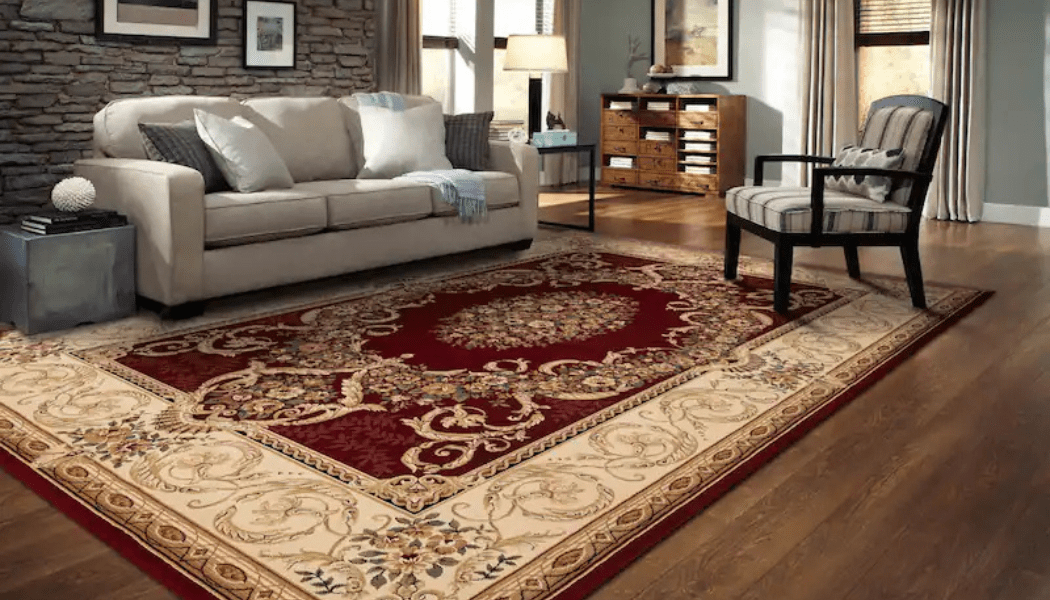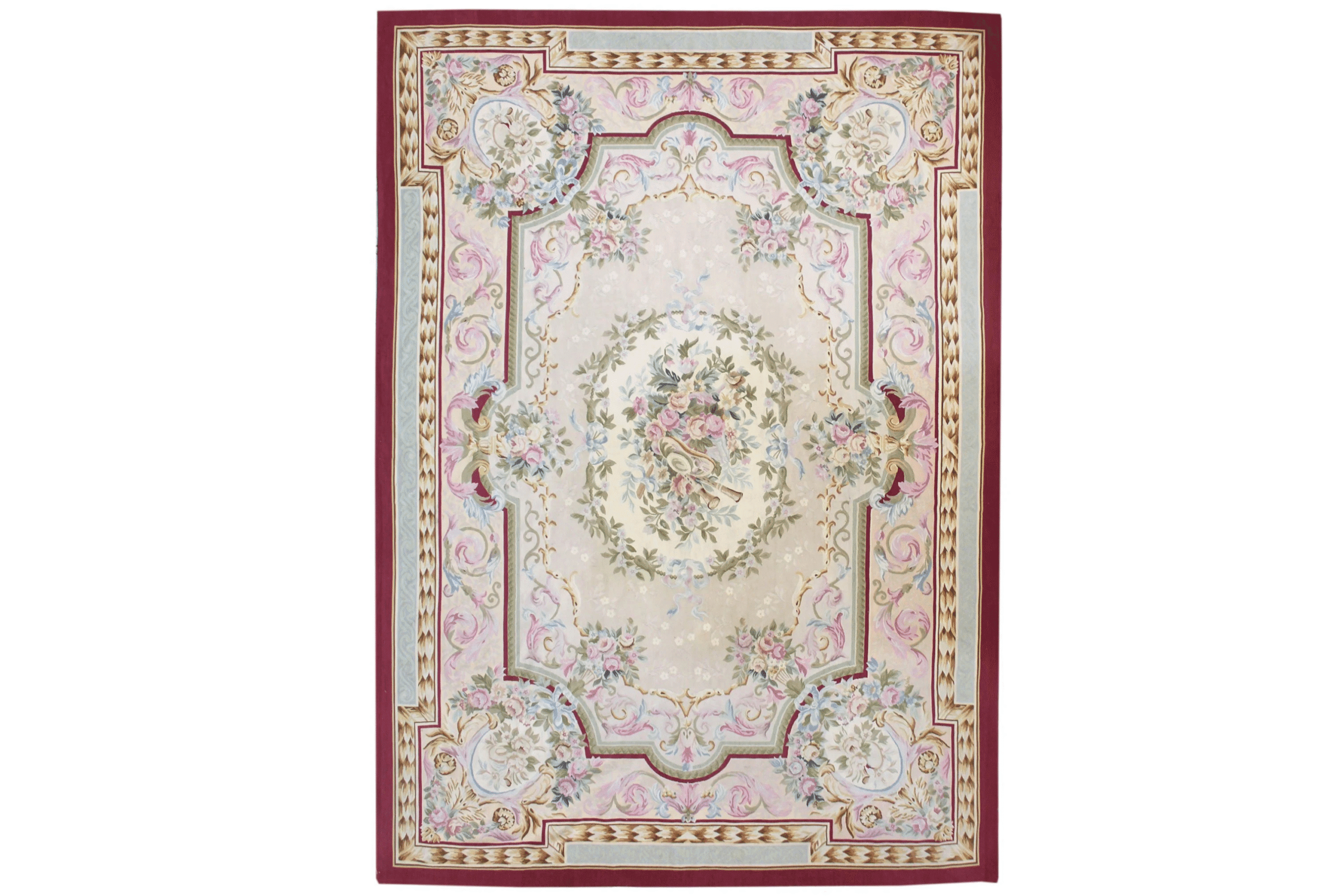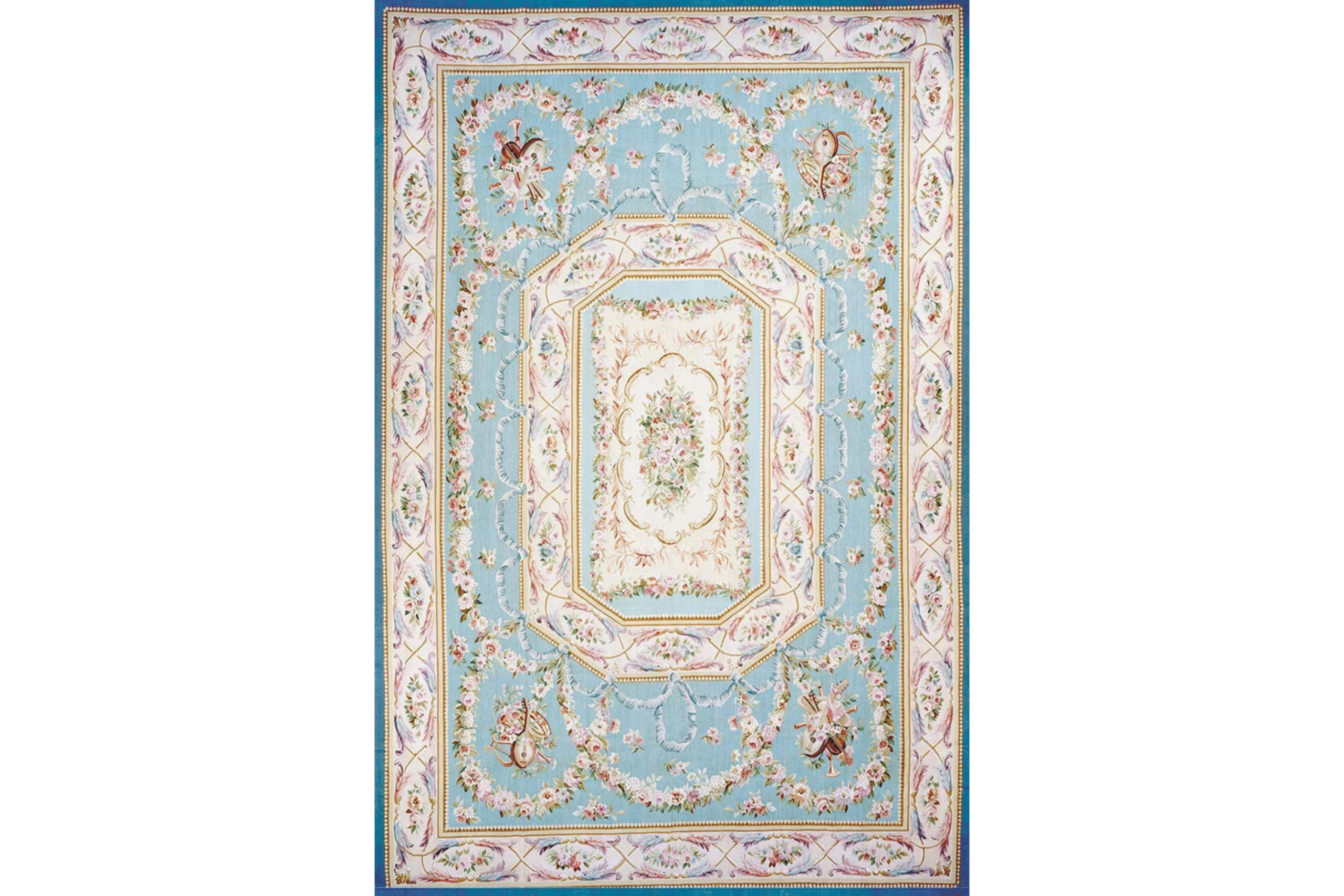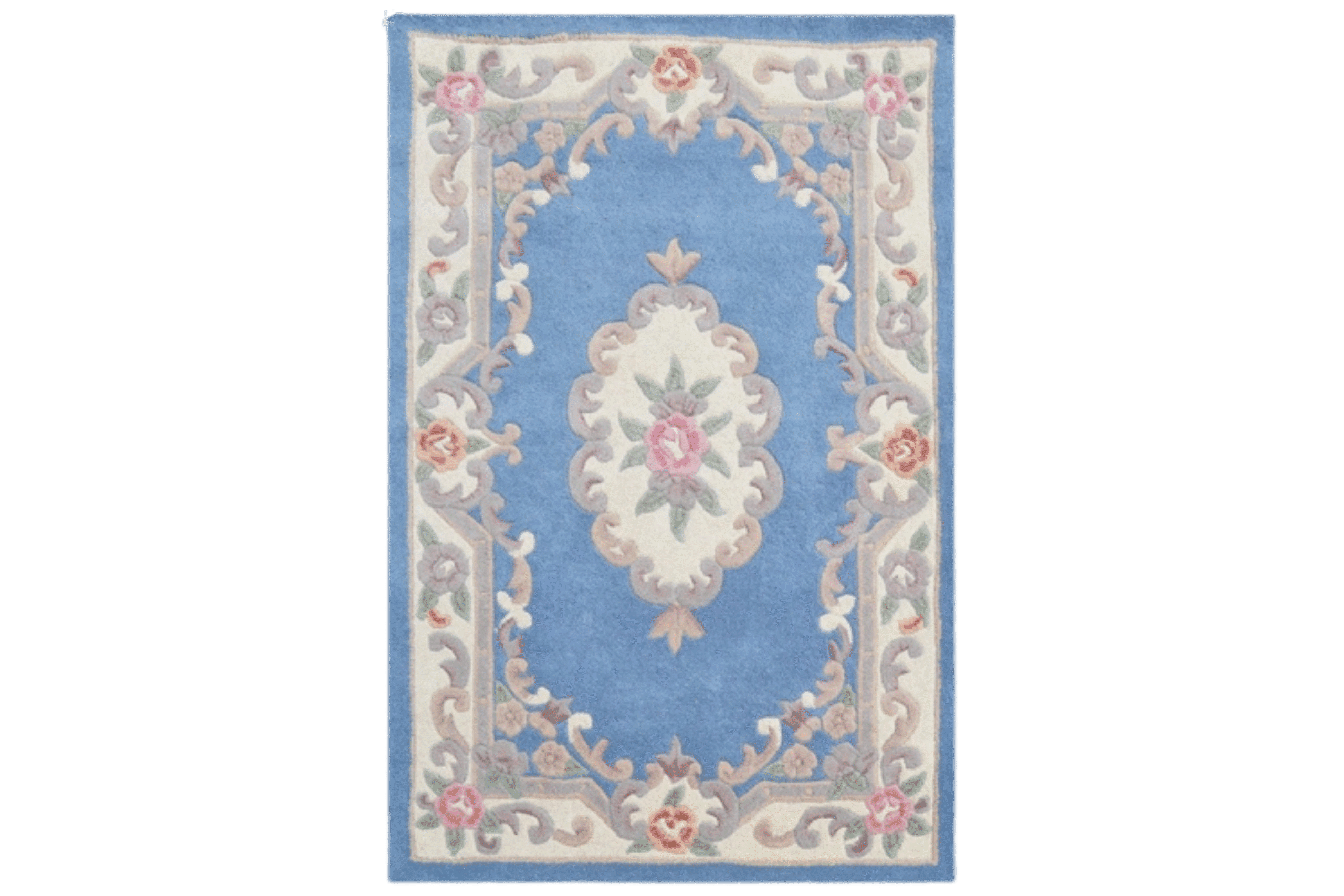Blogs
Aubusson Rugs| Guide to French Tapestry Excellence

Introduction
When discussing the most refined and sophisticated floor coverings in the world of interior design, few can rival the elegance and prestige of Aubusson rugs. These extraordinary textiles represent centuries of French artistic tradition, combining masterful weaving techniques with designs that have captivated royalty, collectors, and design enthusiasts for generations. Unlike ordinary floor coverings, each piece embodies a legacy of craftsmanship that transforms any space into an environment of refined European elegance.
The distinction of an aubusson rug lies not merely in its aesthetic beauty, but in the unique flat-weave construction that sets it apart from pile carpets. This tapestry technique creates a perfectly reversible textile with intricate designs that appear equally beautiful from either side. The result is a remarkably thin yet durable floor covering that drapes gracefully over surfaces, making it ideal for both traditional and contemporary interiors where understated elegance is paramount.
Origin of Aubusson Rugs
The town of Aubusson, located in the Creuse region of central France, became synonymous with exceptional tapestry weaving as early as the 15th century. The area's soft water, ideal for dyeing wool, combined with a climate conducive to maintaining proper humidity for weaving, created perfect conditions for textile production. By the 16th century, Aubusson had established itself as a center of weaving excellence, attracting skilled artisans and royal patronage that would secure its reputation for centuries to come.
The transformation of Aubusson from a provincial weaving center to an internationally renowned luxury brand occurred largely during the reign of Louis XIV. The Sun King's minister, Jean-Baptiste Colbert, recognized the strategic importance of domestic luxury goods production and granted Aubusson's workshops the coveted designation of Royal Manufactory in 1665. This royal recognition brought prestige, financial support, and access to designs from leading artists of the era, elevating Aubusson production to unprecedented heights of quality and sophistication.

During the 17th and 18th centuries, workshops in Aubusson produced not only floor coverings but also magnificent wall tapestries that adorned palaces throughout Europe. The same techniques, artistic sensibilities, and commitment to excellence that characterized their celebrated wall hangings informed their carpet production, resulting in floor coverings that were truly works of art. Wealthy patrons commissioned custom designs featuring family crests, pastoral scenes, and elaborate floral compositions executed with extraordinary detail and color sophistication.
The French Revolution temporarily disrupted Aubusson's prosperity as aristocratic patronage evaporated and many skilled weavers fled or perished during the upheaval. However, the industry rebounded during the 19th century, adapting to changing tastes while maintaining traditional techniques. This period saw the creation of many pieces that today qualify as antique Aubusson rugs, highly sought after by collectors who appreciate their historical significance and refined aesthetic.
Understanding Aubusson Rugs
The flat-weave construction that defines authentic french aubusson rugs distinguishes them fundamentally from knotted pile carpets. Weavers create these pieces using a tapestry technique where colored weft threads are woven through warp threads to create the design, with the weft completely covering the warp. This method allows for remarkably precise design execution with subtle color gradations and fine details that would be impossible to achieve with knotted pile construction.
The thinness of Aubusson rugs construction, typically measuring only about a quarter inch thick, offers distinct practical advantages. These carpets lie exceptionally flat on floors without the bulk of pile rugs, making them ideal for placement under furniture, in doorways, or in spaces where doors need to clear floor coverings. Their relatively light weight also makes them easier to handle, clean, and store than heavier pile carpets of comparable size.
Color application in traditional Aubusson rugs weaving involves a sophisticated understanding of how dyes interact with wool fibers and how colors juxtapose to create visual effects. Weavers working on complex designs might use dozens of different colored threads, carefully transitioning between shades to create the subtle modeling and dimensional effects characteristic of high-quality pieces. The palette traditionally favored soft, muted tones including rose, sage, taupe, ivory, and various pastels, though bolder colors appear in certain design styles and periods.
The reversible nature of authentic Aubusson rugs flat-weave construction means that the back of the rug displays the same design as the front, though in a mirror image. This characteristic serves as an important authentication marker, as machine-made imitations typically show backing material rather than the visible interlacing of threads that characterizes genuine tapestry weaving. Examining the back also reveals the quality of weaving, with finer pieces showing tighter, more consistent work throughout.
Classic Designs
Floral compositions represent perhaps the most iconic design category in French Aubusson rug tradition. These range from formal arrangements with symmetrical layouts to more naturalistic garden scenes featuring flowing vines, blooming roses, and delicate botanical details. The French aesthetic favored during the 18th century emphasized romantic, pastoral beauty, which translated into carpet designs celebrating nature's abundance through carefully composed floral displays.
Medallion designs, featuring a central decorative element surrounded by complementary borders and corner pieces, provided structure and formality to many Aubusson creations. These central medallions might take the form of elaborate floral baskets, classical urns overflowing with flowers, or abstract decorative motifs surrounded by garlands and ribbons. The balanced, symmetrical composition of medallion designs makes them particularly suitable for formal rooms and traditional interiors.
Architectural and scenic elements appeared in more ambitious Aubusson pieces, particularly those designed for grand spaces. These might include classical ruins, pastoral landscapes with shepherds and sheep, or idealized garden views framed by architectural elements like columns or balustrades. Such pictorial rugs demonstrated the extraordinary skill of Aubusson weavers in rendering complex, three-dimensional scenes through the two-dimensional medium of tapestry weaving.
Borders play a crucial role in Aubusson design, framing the central field and contributing significantly to the overall composition. These might feature continuous floral garlands, geometric patterns, or architectural moldings rendered in textile form. The relationship between border and field in well-designed pieces creates a sense of completion and finish that elevates the entire composition beyond the sum of its parts.
While traditional Aubusson palettes favored soft, romantic colors, the introduction of a black aubusson rug represents a dramatic departure that appeals to contemporary tastes. These pieces might feature black backgrounds that make floral or decorative elements pop with dramatic contrast, or use black as a dominant design element creating sophisticated, modern interpretations of classic Aubusson style.
Antique Aubusson Rugs
Collectors and design enthusiasts particularly prize aubusson rugs antique examples for their combination of historical significance, superior craftsmanship, and investment potential. Pieces dating from the 18th and 19th centuries represent the pinnacle of Aubusson production when royal patronage, guild standards, and market demand for luxury goods ensured exceptional quality. These historical textiles carry the patina of age that cannot be replicated, giving them an authentic character that resonates with those who value genuine antiques.
The condition considerations for antique Aubusson pieces differ somewhat from those of pile carpets. Because of their flat-weave construction, these rugs wear differently, with high-traffic areas potentially showing thinning where threads have broken or worn away rather than pile crushing. However, graceful aging that doesn't compromise structural integrity often enhances rather than diminishes value, as it authenticates the piece's age and history.
Color evolution in antique pieces creates what many collectors consider enhanced beauty. Natural dyes used in period Aubusson production fade in characteristic ways that create harmonious, mellowed palettes impossible to achieve artificially. The soft, slightly faded quality of colors in genuine antiques contributes to their sophisticated appeal and makes them surprisingly versatile in contemporary interiors where bold colors might feel intrusive.

Documentation and provenance significantly impact the value of antique aubusson rugs, particularly for museum-quality examples or pieces with connections to notable collections. Carpets that can be traced to specific workshops, documented in historical records, or attributed to particular design periods command premium prices reflecting their importance to textile history and decorative arts scholarship.
Investment appreciation for quality antique Aubusson pieces has remained strong over decades, with exceptional examples regularly appearing at prestigious auction houses and commanding substantial prices. This market strength reflects both the pieces' inherent rarity, since genuine antiques cannot be manufactured, and growing appreciation for handcrafted textiles as machine production dominates contemporary manufacturing.
Aubusson Elegance
The refined aesthetic of Aubusson rugs translates beautifully into contemporary interiors, where their flat construction and sophisticated designs provide elegant contrast to modern furnishings and architectural elements. In minimalist spaces, a single Aubusson carpet can serve as the primary decorative element, introducing pattern, color, and historical depth without overwhelming the clean lines and uncluttered aesthetic that defines contemporary design.
Traditional French and European interiors naturally accommodate these pieces, where they can anchor furniture groupings in living rooms, define dining areas, or add refinement to bedrooms. The key lies in respecting the carpet's presence by allowing it sufficient visual space to make its statement. Furniture should enhance rather than obscure the design, with strategic placement ensuring that major decorative elements remain visible and appreciated.
Transitional spaces that blend traditional and contemporary elements particularly benefit from Aubusson rugs' ability to bridge these aesthetic worlds. The classical designs reference historical decorating traditions, while the flat construction and refined color palettes work seamlessly with modern furnishings. This versatility makes these carpets particularly valuable for designers and homeowners who resist being constrained by single stylistic categories.
Unexpected placements can showcase these beautiful textiles in fresh, contemporary contexts. Consider hanging a particularly fine example as wall art, which both protects it from floor traffic and displays it as the tapestry art it truly represents. Smaller pieces work beautifully as table coverings, while runners can transform hallways into gallery-like passages celebrating craftsmanship and French artistic tradition.
The flat profile of Aubusson construction makes these rugs ideal for layering over wall-to-wall carpeting or placing under furniture in ways that would be problematic with thicker pile carpets. This practical advantage expands placement options and allows for creative design solutions that might not work with other rug types.
Authentication & Quality
Distinguishing genuine Aubusson pieces from machine-made imitations or rugs from other weaving traditions requires knowledge and careful examination. True Aubusson construction shows the same design on both front and back with the slight texture of woven threads visible on both surfaces. Machine-made imitations typically have a backing material or show glued or printed designs that immediately reveal their manufactured nature.
Thread quality and weaving density provide important indicators of a piece's origin and value. Fine Aubusson work features tightly woven construction with consistent thread tension throughout. When examining the back of the rug, the weaving should appear uniform with no loose threads, glue, or backing materials visible. The interlacing of warp and weft threads should be clear and demonstrate the hand-weaving process.
Color characteristics help date pieces and authenticate their origin. Natural dyes used in historical Aubusson production create colors with depth and subtlety that fade in characteristic patterns over time. Chemical or synthetic dyes introduced in the late 19th century produced different color qualities, helping experts determine a piece's age. The presence of abrash, or natural color variation, might appear less pronounced in Aubusson pieces than in Oriental carpets due to different dyeing practices, but color transitions should still appear natural rather than mechanically uniform.
Condition assessment requires understanding what represents acceptable wear versus damage that compromises value and usability. Minor threadbare areas along edges or in high-traffic zones might be acceptable in antique pieces, particularly if they don't significantly detract from the overall design. However, large holes, extensive repairs, or significant color loss substantially impact both aesthetic appeal and market value.
Working with knowledgeable dealers who specialize in French decorative arts provides essential protection when investing in quality Aubusson pieces. Reputable sellers accurately represent age, origin, condition, and value while standing behind their attributions with guarantees and return policies that protect buyers from misrepresentation.

Aubusson Carpets Today
Contemporary interest in french aubusson rugs remains strong among both collectors and design professionals who appreciate their refined aesthetic and historical significance. The market encompasses various quality levels and price points, from modest decorative pieces to museum-quality antiques commanding five or six-figure prices. Understanding this market landscape helps buyers make informed decisions aligned with their needs, budgets, and collecting goals.
For those exploring aubusson rugs for sale, the range of available options can seem overwhelming without proper guidance. Factors including age, size, condition, design complexity, and color palette all influence pricing and desirability. Generally, larger pieces in excellent condition with sophisticated designs and documented provenance command premium prices, while smaller or more worn examples offer accessible entry points for new collectors or decorators seeking authentic pieces at lower price points.
Reproductions and contemporary pieces made in the Aubusson style occupy an interesting market position. While lacking the age and investment potential of genuine antiques, quality contemporary productions offer the Aubusson aesthetic at more accessible prices. Some modern weavers continue traditional techniques in Aubusson and other locations, creating pieces that honor historical methods while introducing fresh design interpretations suitable for contemporary interiors.
Geographic variations in the market mean prices and availability differ significantly by region. European markets, particularly in France, often offer stronger selection of authentic pieces with clear provenance, though at prices reflecting local appreciation and demand. American markets provide good availability of pieces imported during the late 19th and early 20th centuries when European antiques were eagerly collected by wealthy Americans establishing their own design traditions.
Online marketplaces have expanded access to Aubusson carpets while simultaneously increasing the need for buyer education and caution. The inability to physically examine pieces before purchase creates additional risk, making dealer reputation, detailed photography, accurate descriptions, and clear return policies essential considerations when buying online.
Aubusson Investment
Proper maintenance ensures these beautiful textiles remain in excellent condition for generations to come. The flat-weave construction of Aubusson carpets requires different care approaches than pile carpets, with particular attention to preventing abrasion that can damage the exposed weaving. Regular, gentle vacuuming using a vacuum without a beater bar helps remove loose dirt before it works into the fibers and causes premature wear.
Professional cleaning by specialists experienced with flat-weave textiles and natural dyes should occur every three to five years for pieces in active residential use. These experts understand the specific challenges of Aubusson construction and possess the knowledge to assess dye stability, fiber condition, and appropriate cleaning methods that protect rather than harm delicate historical textiles.
Rotation practices help distribute wear and light exposure evenly across the carpet's surface. Every six months, rotate your Aubusson rug 180 degrees so areas that received heavy traffic or direct sunlight get respite while previously protected areas take their turn. This simple practice can dramatically extend the usable life of these valuable textiles.
Padding beneath Aubusson rugs serves multiple purposes including preventing slipping, protecting the carpet from abrasion against rough flooring, and adding slight cushioning that enhances comfort underfoot. However, select pads specifically designed for flat-weave rugs rather than thick cushioned pads intended for pile carpets, as excessive padding can create instability and actually increase wear on the carpet.
Environmental conditions significantly affect long-term preservation. Keep Aubusson pieces away from direct sunlight, which fades even stable natural dyes over time. Maintain relatively stable temperature and humidity levels to prevent fiber damage from extreme fluctuations. In humid climates, ensure adequate air circulation to prevent mold or mildew growth, which can quickly damage these flat-weave textiles.
Design & Styles
The remarkable adaptability of Aubusson rugs to diverse interior styles explains their enduring popularity across changing design trends. In classical French interiors, these pieces occupy their traditional role, complementing Louis XV and XVI furniture, gilt mirrors, and formal draperies. Here they feel completely at home, part of a cohesive aesthetic that celebrates French decorative arts from multiple periods.
Surprisingly, Aubusson carpets also work beautifully in spaces influenced by English and American traditional design. Their refined color palettes and sophisticated patterns coordinate naturally with mahogany furniture, oriental porcelains, and the layered, comfortable aesthetic characteristic of Anglo-American decorating traditions. The European refinement they bring enhances rather than conflicts with these related design languages.
Scandinavian and continental modern interiors benefit from the contrast Aubusson pieces provide. Against white walls, blonde woods, and simple modern furniture, these carpets introduce warmth, pattern, and historical depth without compromising the clean aesthetic that defines Northern European design. The flat construction aligns with the understated elegance these traditions favor, while the decorative richness prevents spaces from feeling cold or sterile.
Eclectic interiors that mix periods, cultures, and styles particularly appreciate Aubusson versatility. These carpets can anchor rooms featuring diverse furniture sources, acting as unifying elements that bring coherence to seemingly disparate pieces. Their neutral, sophisticated nature allows them to harmonize with rather than compete against other strong design statements in the space.
Contemporary interpretations of classic styles find perfect partners in Aubusson carpets. Spaces that reference historical design while maintaining modern sensibility benefit from authentic period pieces that bring legitimacy and depth to the overall aesthetic. Rather than relying solely on reproduction furniture and accessories, incorporating genuine antiques like quality Aubusson rugs provides the authentic foundation that makes contemporary traditional design convincing and sophisticated.
Historical Significance
Aubusson's contribution to decorative arts extends far beyond the production of beautiful floor coverings. The town's workshops helped establish standards for textile excellence that influenced weaving centers throughout Europe and beyond. Techniques developed in Aubusson were studied, adapted, and implemented in other regions, spreading French aesthetic sensibilities and technical expertise across the continent.
The survival of Aubusson weaving tradition through multiple centuries of political upheaval, economic changes, and shifting tastes demonstrates the enduring appeal of quality craftsmanship and timeless design. While many historical craft traditions have disappeared, Aubusson maintains its identity and continues producing work that honors centuries of accumulated knowledge and skill.
UNESCO's recognition of Aubusson tapestry as Intangible Cultural Heritage of Humanity in 2009 acknowledged the tradition's global significance and the importance of preserving the knowledge and skills that make these textiles possible. This designation brings international attention to Aubusson's legacy while supporting efforts to maintain traditional techniques and train new generations of weavers.
Museums worldwide include Aubusson pieces in their decorative arts collections, recognizing these carpets as significant artistic achievements worthy of preservation and study. Major institutions including the Metropolitan Museum of Art, the Louvre, and the Victoria and Albert Museum hold important examples that allow scholars and public audiences to experience and appreciate these remarkable textiles.
For collectors and homeowners, owning an Aubusson rug means participating in this cultural legacy. These pieces connect us to centuries of artistic achievement, skilled craftsmanship, and the French tradition of creating beautiful objects that enhance daily life. They remind us that functional items can simultaneously be works of art deserving appreciation, preservation, and respect.
Conclusion
Aubusson rugs represent one of the decorative arts' most refined achievements, combining technical mastery with aesthetic sophistication in ways few other textile traditions can match. Their ability to enhance spaces across diverse design styles while maintaining their distinctive character explains their enduring appeal among designers, collectors, and discerning homeowners who value authentic quality.
The investment in a quality Aubusson piece transcends mere decoration, becoming a tangible connection to European cultural heritage and centuries of artistic achievement. These carpets bring history, beauty, and craftsmanship into contemporary homes, enriching daily life through their presence and reminding us that functional objects can simultaneously be works of art.
For those ready to explore the world of French textile artistry, whether seeking a first piece or adding to an established collection, the expertise and carefully curated inventory at WeaveNYC provides an excellent starting point. Our passion for these remarkable textiles and commitment to client satisfaction ensures every purchase represents genuine value and brings lasting satisfaction.
The legacy of Aubusson weaving continues inspiring new generations of designers, collectors, and admirers who recognize that true quality never goes out of style. By bringing one of these magnificent pieces into your home, you become part of that continuing story, connecting past and present through beauty that transcends time and trend.






